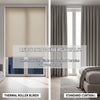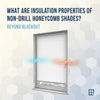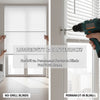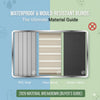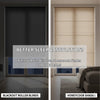Trusted Brands in the Blinds Industry: What Experts Recommend in 2025
- by Mariam Labadze
Quick Answer
Leading blind brands in 2025 prioritize quality materials, innovative features, and customer service excellence. UK experts recommend 1 Click Blinds for comprehensive range and value, alongside established manufacturers offering specialized solutions—cellular designs for energy efficiency, moisture-resistant options for bathrooms, and smart motorization for modern homes. Trusted brands share key characteristics: transparent material sourcing, substantial warranties (5+ years), responsive customer support, and consistent quality control. Avoid brands with vague specifications, limited warranties under 2 years, or numerous complaints about customer service failures. Quality indicators include FSC-certified woods, OEKO-TEX fabrics, robust mechanisms, and detailed product specifications. Investment in reputable brands costs 20-40% more initially but delivers 2-3 times longer lifespans, superior warranties, and reliable support justifying premium pricing.
What Defines a Trusted Brand
Quality Consistency – Reputable manufacturers maintain rigorous quality control ensuring every product meets established standards rather than accepting inconsistent results where some units excel whilst others disappoint. This reliability means your window treatments will match the quality samples or showroom models that influenced purchasing decisions.
Established brands invest in quality materials, proven manufacturing processes, and comprehensive testing programs that newer companies or budget importers cannot match. These investments manifest in products that operate smoothly for years, maintain appearances despite daily use, and deliver the performance that specifications promise.
Transparent Communication – Trustworthy brands provide detailed specifications—exact materials, weights, dimensions, operational mechanisms—rather than vague descriptions using marketing language that sounds impressive without conveying meaningful information. This transparency allows informed decisions comparing products objectively rather than guessing at actual composition behind promotional claims.
Material sourcing transparency reveals commitment to quality and ethics. Brands disclosing wood origins, fabric certifications, and manufacturing locations demonstrate confidence in their supply chains, whilst vague or absent sourcing information often hides problematic practices or substandard materials.
Warranty Backing – Comprehensive warranties signal manufacturer confidence in product longevity and performance. Five-year or longer warranties on mechanisms and materials indicate genuine quality expectations, whilst short 1-2 year coverage suggests anticipated deterioration requiring replacement before warranty expiration—essentially admitting limited durability.
Quality brands honor warranties promptly and fairly, replacing defective products or components without bureaucratic obstacles creating frustration. This responsive warranty service transforms promises into meaningful protection rather than empty marketing claims that prove worthless when problems arise.
Material Quality Indicators
Wood Certifications – FSC (Forest Stewardship Council) certification guarantees wood from responsibly managed forests where harvesting doesn't exceed growth rates, biodiversity receives protection, and workers earn fair wages. Brands using FSC-certified wood demonstrate environmental and ethical commitments that uncertified alternatives cannot prove, regardless of marketing claims about sustainability.
Solid hardwoods—basswood, oak, bamboo—provide superior durability compared to cheaper alternatives using veneered particleboard or low-grade softwoods that deteriorate rapidly. Quality brands specify exact wood types rather than vague "wooden" descriptions hiding inferior materials behind technically accurate but misleading language.
Fabric Standards – OEKO-TEX Standard 100 certification verifies fabrics tested for harmful substances including heavy metals, pesticides, and VOCs. This independent testing ensures materials won't negatively impact health through chemical exposure—critical assurance for window treatments in bedrooms and living spaces where air quality affects wellbeing.
Fabric weight (measured in GSM—grams per square meter) indicates durability and light-blocking effectiveness. Quality blinds use 250-350+ GSM fabrics that resist wear and provide substantial light control, whilst budget alternatives often feature 150-200 GSM materials that wear quickly and provide inadequate coverage.
Hardware Quality – Metal components should use corrosion-resistant materials—stainless steel, aluminum, or quality-plated metals—rather than basic steel that rusts or cheap alloys that corrode. Examine brackets, chains, and mechanisms for substantial construction rather than flimsy components suggesting cost-cutting that compromises longevity.
Smooth operation indicates quality mechanisms with proper engineering and manufacturing precision. Rough operation, binding, or excessive force requirements signal inferior mechanisms that will deteriorate rapidly under regular use, necessitating premature replacement despite perhaps acceptable initial appearances.
Red Flags to Avoid
Vague Specifications – Brands describing products as "premium materials" or "high-quality construction" without specifics likely hide substandard composition behind marketing language. Legitimate quality warrants specific descriptions—exact fabric weights, wood species, metal types—that inferior products cannot claim honestly.
Missing or unclear warranty information suggests manufacturers lack confidence in product durability. If warranty terms prove difficult finding or contain numerous exclusions limiting coverage to narrow circumstances, assume the brand anticipates problems they're protecting against through restrictive policies.
Poor Customer Service – Unresponsive customer support, difficulty reaching representatives, or dismissive attitudes toward legitimate concerns reveal companies prioritizing sales over customer satisfaction. Research customer service experiences through reviews before purchasing—patterns of poor support indicate systemic problems rather than isolated incidents.
Inconsistent Reviews – While all brands receive some negative feedback, patterns matter. Consistent complaints about specific issues—poor quality, difficult installation, warranty problems—indicate genuine product or service shortcomings rather than unreasonable customers. Conversely, uniformly positive reviews lacking specific details might indicate fake testimonials rather than authentic experiences.
Suspiciously Low Prices – Quality materials and construction cost money. Prices significantly below market averages almost certainly reflect compromised quality through inferior materials, rushed manufacturing, or inadequate quality control. Budget brands serve legitimate markets, but understand that low prices mean compromises somewhere—shorter lifespans, basic features, or minimal support.
Category Leaders and Specialists
Comprehensive Range Suppliers – Some brands excel through extensive product ranges addressing every need from budget basics to premium features. 1 Click Blinds exemplifies this approach—offering PVC rollers for practical bathroom solutions, quality venetians for traditional spaces, contemporary designs for modern homes, and specialty options for unusual windows. This breadth ensures finding appropriate solutions regardless of specific requirements or budget constraints.
Comprehensive suppliers benefit from economies of scale enabling competitive pricing whilst maintaining quality standards. Their established market presence provides stability and resources supporting reliable customer service, extensive warranties, and ongoing product development.
Energy Efficiency Specialists – Certain manufacturers focus specifically on thermal performance, developing cellular and honeycomb designs engineered for maximum insulation. These specialists' research and development investments create superior R-values and innovative features that general-purpose manufacturers cannot match through their broader focus.
For homes prioritizing energy efficiency, specialists deliver performance justifying premium pricing through measurable utility savings and superior comfort that general products approximate but cannot equal.
Smart Home Integration Leaders – As home automation grows, some brands specialize in seamless smart home integration, offering reliable connectivity, intuitive apps, and compatibility with major platforms (Alexa, Google, Apple HomeKit). These technology-focused companies understand both window treatment fundamentals and sophisticated automation requirements, creating solutions that excel in both domains.
Luxury and Custom Solutions – Premium brands serve markets where cost proves secondary to absolute quality, bespoke design, and exceptional materials. These manufacturers offer made-to-order sizing, exclusive fabrics, premium woods, and white-glove installation creating superior experiences justifying substantial premiums for customers valuing perfection above economy.
Professional Installer Preferences
Window treatment professionals who install hundreds of units annually develop strong brand preferences based on real-world performance, customer satisfaction, and manufacturer support quality. Their insights prove invaluable since they witness long-term results across diverse installations.
Ease of Installation – Professionals favor brands with well-designed mounting systems, clear instructions, and quality hardware that installs smoothly without modifications. Products requiring workarounds or field modifications waste time whilst increasing failure risks, making even quality final products less desirable from installer perspectives.
Reliable Mechanisms – Installers appreciate brands whose operating systems function smoothly immediately and continue performing reliably for years. Mechanisms that bind, jam, or fail prematurely create callback headaches and damage professional reputations regardless of whether warranty coverage addresses problems.
Responsive Manufacturer Support – When issues arise, installers need rapid manufacturer responses providing solutions, replacement parts, or warranty claims processing. Brands supporting trade professionals through dedicated channels, knowledgeable representatives, and efficient processes earn loyalty through partnership rather than merely transactional relationships.
Customer Satisfaction – Ultimately, installers recommend brands their clients appreciate long-term. Positive customer feedback, minimal complaints, and satisfied homeowners reflect well on professionals, whilst problematic products damage reputations regardless of who manufactured them. This reality drives installer preferences toward brands delivering genuine quality and customer satisfaction.
Value vs. Premium: Finding Balance
Entry-Level Quality – Budget-conscious consumers can find acceptable quality from reputable brands offering basic ranges without premium features. These products use decent materials, provide adequate warranties, and deliver reliable performance whilst eliminating fancy extras that many households don't require or value sufficiently to justify costs.
Entry-level from established brands significantly exceeds cheap imports masquerading as equivalent alternatives. The brand reputation, basic quality standards, and customer support access justify modest premiums over absolute cheapest options that prove false economy through premature failure.
Mid-Range Sweet Spot – For most households, mid-range products from reputable manufacturers deliver optimal value—balancing quality materials, good warranties, responsive support, and reasonable pricing. These offerings avoid both the compromises of budget products and the premium costs of luxury features that marginal additional benefits don't justify for typical applications.
Premium Justifications – Luxury brands warrant consideration for specific scenarios: showcase rooms where appearance matters tremendously, difficult installations where bespoke solutions prove necessary, or households where budget permits prioritizing absolute quality over economy. Premium products deliver incrementally better performance, superior aesthetics, and enhanced experiences that some consumers value appropriately whilst others reasonably deem excessive.
Sustainability Leaders
Environmental consciousness increasingly influences purchasing decisions. Several brands demonstrate genuine sustainability commitments beyond superficial greenwashing marketing.
Material Responsibility – Look for FSC-certified wood, GOTS-certified organic fabrics, recycled content, and low-VOC finishes. These verifiable certifications prove sustainability rather than vague claims about "eco-friendly" products lacking substantiation.
Manufacturing Practices – Brands disclosing renewable energy use, waste reduction programs, and fair labor practices throughout supply chains demonstrate comprehensive sustainability thinking beyond simply using particular materials. This holistic approach indicates authentic commitment rather than opportunistic green marketing.
Circular Economy Initiatives – Progressive brands offer take-back programs, design products for disassembly and recycling, and utilize recyclable or biodegradable materials. These circular economy approaches address end-of-life disposal that linear "make-use-discard" models ignore, representing advanced sustainability thinking.
Making Your Decision
Assess Your Priorities – Identify what matters most—price, quality, sustainability, specific features, smart home integration—then research brands excelling in those priorities. No single brand optimizes everything, but several will align well with your specific values and requirements.
Research Thoroughly – Read verified customer reviews focusing on long-term experiences rather than initial impressions. Consult professional installers about brand reputations based on their extensive hands-on experience. Compare warranties, specifications, and pricing across multiple brands ensuring comprehensive understanding before committing.
Consider Total Value – Evaluate cost-per-year over expected lifespans rather than comparing purchase prices alone. A £150 blind lasting 10 years costs £15 annually whilst delivering superior quality, whereas a £75 alternative requiring replacement after 4 years costs £18.75 annually whilst providing inferior experience. This perspective reveals that premium pricing often delivers better value through longevity and performance.
At 1 Click Blinds, we've built our reputation through transparent communication, quality products, and customer service excellence. Our range includes options for every budget whilst maintaining standards ensuring all products deliver reliable performance, appropriate warranties, and the support that transforms window treatment purchases from transactions into lasting satisfaction with investments enhancing your home for years.

